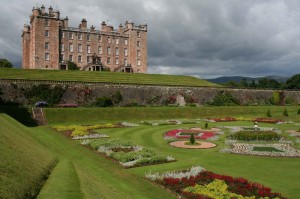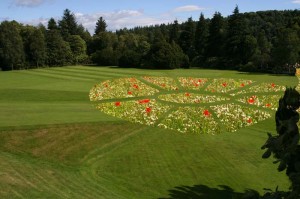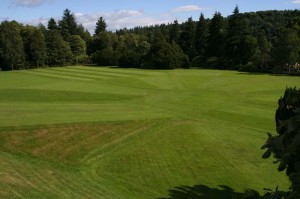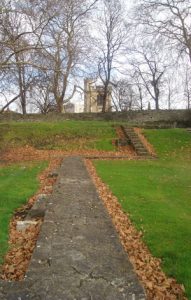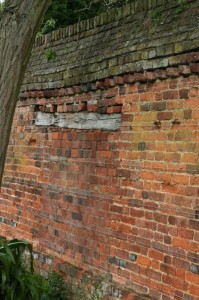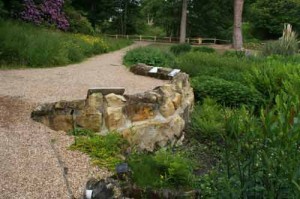PALACE Residences. – There is no gentleman’s house in the west of Scotland, that, in its present state, can properly be, denominated a palace residence; but Drumlanrig, from its commanding situation, the extensive territory belonging to it, and the wealth and rank of its owner, we shall here consider as of this class. We feel the more justified in doing so, from the extensive improvements now carrying on in the grounds, and which will, doubtless, in a short time, be extended to the house. Nothing can exceed the dignity of the situation of this edifice; placed on a knoll, on the summit of an advancing ridge, backed by an extensive range of wooded hills and mountains, and commanding, in front, and to the right and left, as far as the eye can reach, a varied surface of corn and posture land, watered by a considerable stream which skirts the margin of the park, and terminating in hills of heath and pasture in the horizon. To whatever side the eye turns of this extensive and magnificent prospect, the whole is the property of the Duke of Buccleugh. As this property now exists, in a general point of view, there is little for the landscape-gardener to do, except forming two new approaches to the house, a new kitchen-garden; and modifying, by planting and by some changes on the surface, the park and pleasure-ground. An excellent kitchen-garden is already walled round, and the gardener’s house, about to be commenced, we were informed, will be the first in Scotland, not only as a commodious and complete dwelling, but as a specimen of cottage Gothic architecture. The designer of the garden,. Mr. Hannay, is the present head gardener at Drumlanrig; and the architect of the house is Mr. Burn of Edinburgh. As far as we saw the new line of approach, it did not appear to us at all satisfactory; because we could not conceive how the ascent to the house by it could be rendered either easy to travel over, or agreeable to the eye.
Judging from a hasty glance, we should say that the best way to procure two approaches of perfectly easy ascent, and descent, of great beauty and variety in the views seen from it, and of striking effect on arriving at the house, would be, to commence two or three miles to the right and left, and to lead from the present public road, a private one, on a uniform but very gentle slope, along the side of the range of hills at the back, or what is, we believe, the south side of the present flower-gardens. We would there form a court-yard to the palace, instead of the present one on the western front, reserving the extensive prospect from the north front to be obtained by the stranger first from the windows. As pleasure-ground, we would follow up the present style of the place, and form such additions and variations as would place two ranges of terrace-gardens on each side of the east, west, and north fronts. The beautiful terrace-gardens already existing show with how much effect this might be done. Whether we might not change the course of the river in some places, or produce ramifications from it, in such a way as to show more water from the palace windows, we did not take time enough to consider; but, at all events, we think we ascertained the practicability of diverting a part of its waters in such a way as to produce a powerful waterfall in one place, and a lake in another. We have great pleasure in stating that the flower-gardens were in the highest order and keeping, and the grass edgings to the walks entirely to our mind. Mr. Hannay we found fully concurring in all that we had said on that subject in our October article.
Some instruction, as well as amusement, may perhaps be obtained by the reader, from the perusal of what the celebrated William Gilpin said of this place, then called Queensberry House, in his Observations relative chiefly to Picturesque Beauty in Scotland, &c., published in 1776. “The garden front of Queensberry House,” he observes, “opens on a very delightful piece of scenery. The ground falls from it, near a quarter of a mile, in a steep sloping lawn, which at the bottom is received by a river; and beyond that rises in lofty woody banks. All these objects are in the grandest style, except the river; which, though not large, is by no means inconsiderable. It is amazing what contrivance has been used to deform all this beauty. The descent from the house has a substratum of solid rock, which has been cut into three or four terraces, at an immense expense. The art of blasting rocks by gunpowder was not in use when this great work was undertaken. It was all performed by manual labour; and men now alive remember hearing their fathers say, that a workman, after employing a whole summer day with his pickaxe, would carry off in his apron all the stone he had chipped from the rock. How much less expensive is it, in general, to improve the face of nature, than to deform it. In improving, we gently follow; in deforming, we violently oppose. The Duke of Queensberry of that day, who carried on these works, seems himself to have been aware of his folly. He bundled up all the accounts together; and inscribed them, as I have been informed, with a grievous curse on any of his posterity who should ever look into them.” (p. 84.) The other observations made by Gilpin on this place are excellent, as, indeed, is all that he has written on picturesque beauty; always, however, making allowance for his almost exclusive admiration of that kind of beauty.
[Ed. The above post was written by John Claudius Loudon in 1831. The photograph was taken in 2008]

